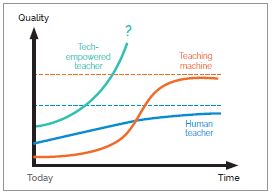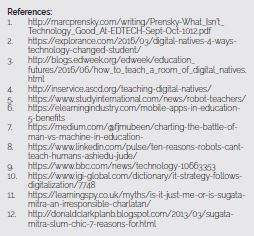by | Sri Widias Tuti Asnam Rajo Intan, sriwidias@might.org.my
…the teaching and learning modes must have an effect on students’ understanding and its application in order to build human resources that are suitable for the Industrial Revolution 4.0
– YB Dr Maszlee Malik, Education Minister
Malaysia’s newly minted Education Minister, Dr Maszlee Malik spared no time in outlining his directions to align education toward Industrial Revolution 4.0. This goes in line with today’s era of digitalisation—the integration of digital technologies into everyday life by means of digitisation. In the context of rapid industry growth, digitalisation means computerisation of systems and job tasks to deliver better education to cater to the needs of today’s digital natives.
In Malaysia, it is emphasis to use 21st-century learning (PAK21) concepts to create a more conducive and more effective learning environment for the students.
Teachers should no longer be using just books and blackboards like during the early independence days.
Characteristics of digital natives
These days, one year old babies, despite not being able to walk or talk, are however savvy enough to operate a touch mobile screen to find the content they want to watch.
Whereas in schools, children in today’s classrooms will most likely be digital natives. Kids who were born in the digital era and have used technology all their lives. They explore the world in an entirely new way. This generation of students grow up with technology (smart phones, Facebook, Instagram, etc.) that allows them to connect with the world instantly.
For higher education institutions, the digital demand is real. In order to stay relevant, colleges and universities must adapt their systems to meet the evolving needs of this new breed of learners. These students are more receptive to instructions involving technology. They are eager for information and are keen to learn beyond traditional subject boundaries (interdisciplinary approach). They see the world as one big network of connections.
Although the future of education is uncertain, the only certainty asssures that it will be led by tech-empowered teachers. Surely these teachers hold huge potential and therefore, we need to ponder how to prepare the future generation by taking into account the following considerations:
• How do we provide them the tools they need to be successful for jobs that don’t yet exist.
• Students are growing into adulthood in a totally different reality than that experienced by their teachers.
• Smart phones present a huge research resource at our fingertips yet are a constant power struggle in the classroom.
How we can benefit from technology in the classroom
Integrating technology into the classroom is must. Rather than debating over allowing the use of smart phones, we should focus on the benefits of the technology. The introduction of applications in the education sector has led to the introduction of new learning methods.
• A savvy teacher might take advantage of smart phones as instructional tools. Using them successfully will increase students’ enthusiasm about knowledge. There are fun games available on mobile applications that indulge students into a healthy thought process and help them understand things from a different perspective.
• Technology provides the ability to showcase creative work such as art and poetry on a global scale and the ability to connect with other people no matter the location. Students can therefore create their own pages and blogs to showcase their work to demonstrate their talent and abilities.
• Communication technology can be of great help in building enduring parent teacher relationhips beyond school walls. Mobile devices for example can help facilitate teachers to respond promptly to parents’ queries and promote higher transparency across the education sector.
• Students are generally very fond of online studies. It is easier for students to search for the appropriate study materials on mobile applications or search engines. It keeps them closer to the study materials and it helps them to segregate the materials.
• Various other student-related activities, such as online payment, school calendar information, timetables, forums, conferences, and social activities can be conveniently communicated via mobile.
Case studies
Professor Sugata Mitra first introduced the project ‘hole-in-the-wall’ to introduce chilren in a Delhi slum to computers. He began the project while he was working for a software company. There, he decided to embed a computer into the wall of his office in Delhi facing the slum.
The children barely went to school. They barely knew any English words and had never seen a computer before and they just didn’t know what the internet was. To his surprise, the children quickly figured out how to use the computer and access the internet.

Professor Sugata Mitra then repeated the experiment across India and noticed that children will learn to do what they want to do. He saw children teaching each other how to use the computer and picking up new skills. Subsequently, the experiments were repeated in many more places and gathered similar results. One group in Rajasthan, learnt how to record and play music on the computer within four hours of it arriving in their village.
The studies concluded that children can learn to use a computer on their own irrespective of who or where they are. His experiments then became more ambitious and global.
What is the lacking from these findings?
The results achieved by these village children were facilitated with the aid of a mediator. Based on claims by Dr. Payal Arora, Associate Professor at the Department of Media and Communication of Erasmus University Rotterdam, disassociating learning from adult guidance can lead to uncritical acceptance of bad content and bad learning habits.
When Arora came across these two ‘hole-in-the-wall’ sites (Almora and Hawalbagh in northern India), she discovered not just the positive tales of self-directed learning but also its failures. One was vandalised and closed down within two months. The other was abandoned and, apparently, had been mostly used by boys to play games. A real problem was sustainability, as no one seemed responsible for the electricity and maintenance bills.
Can AI robots replace teachers?
Nothing can be more boring than sitting in a classroom with a monotone, boring, non-humorous robot teaching us about the world we live in. Educational technologies are currently aiding teachers in their work, not completely taking over them. They are tools, not replacements. However, what are the key “human” skills and important elements of a teacher that can’t be replaced by technology? Let’s delve further.
• Teachers do more than just the one-way task of instructing students. They identify social cues that would be impossible for a machine to parse, especially non-verbal or invisible interactions, that affect the learning experience.
• Teachers help identify roadblocks for their students to overcome. This might be more personal or emotional in nature, that a machine cannot pick up on. Machines do not have the human ability to care of students or to understand each student as an individual, to empathise with each student’s unique struggles and passion.
• Machines simply won’t replace teachers because they can’t inspire students like a good teacher does. Think back to your favourite teachers—did you enjoy their teaching because of their infallible library of knowledge or how they made the subjects they taught come alive for you?
• Teachers are invaluable at cultivating the skillsets their students need (collaboration, critical thinking, imagination, creativity, psychomotor, etc.). This is critically one area that machines lack and are not yet able to do.
• Machines are unable to create a culture of excellence. They are unable to push students to excel. Teachers help to contextualise lessons in real time, which might not be possible for a piece of machine to do. The human connection is necessary for something as key as the act of learning.
The most important thing is a person. A person who incites your curiosity and feeds your curiosity; and machines cannot do that in the same way that people can.
– Steve Jobs
As the late psychologist Albert Bandura explains in the Bandura Theory, children learn in social environments by observing and imitating the behaviour and influence of others. Individuals need to feel a sense of belonging and have meaningful connections, all of which a machine cannot provide.
Conclusion

Instead of asking whether technology has reached a point where it can replace human teachers, we must instead ask ourselves what aspects of the job it can take over to make their lives easier. Teachers world over are overburdened. Instead of merely remembering them on a designated day, (Teacher’s Day cards are appreciable for sure) we should perhaps be focusing on building technology to aid them in these efforts.
Education technologies can help enhance teaching methods by making existing content more dynamic or helping teachers create fresher content that was previously out of their reach due to budgetary and technological constraints. Technology must be built to enable teachers, not replace them. Technology will always remain a tool for teachers.
As we look to prepare our students for the world of tomorrow, holding on to our traditional teaching conventions may not be ideal in the long run. Advances in technology enable us to create a new human-machine symbiosis that can greatly improve how we deliver education to our kids. The heart and mind of every student can only be touched by an inspired teacher, one who takes time to understand their psychological dynamics and makes sure they are well positioned to excel.
I fear the day that technology will surpass our human interaction. The world will have a generation of idiots.
– Albert Einstein











